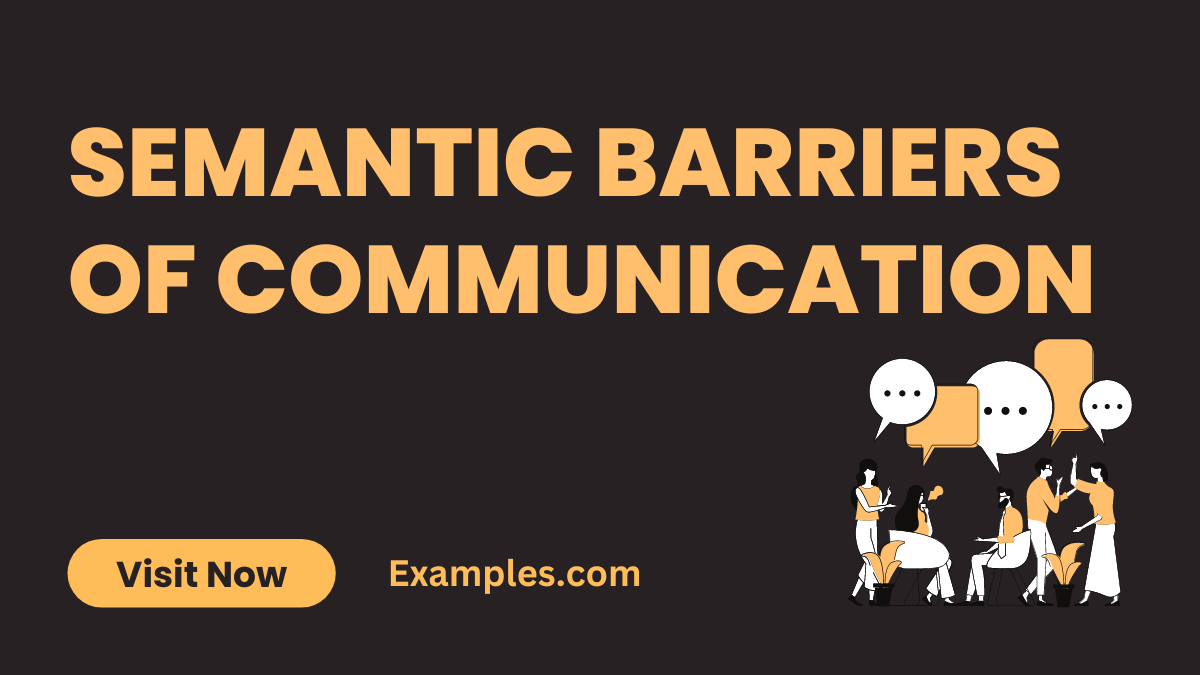19+ Semantic Barriers of Communication Examples
Semantic Barriers of Communication refer to misunderstandings and confusions arising from the interpretation of words and sentences. These barriers occur when the sender and receiver of a message interpret its meaning differently. This can be due to differences in language, jargon, or even cultural nuances in language use. Understanding and overcoming these semantic barriers are essential for ensuring messages are conveyed accurately and effectively, thus improving overall communication and reducing misinterpretations.
What are Semantic Barriers of Communication?
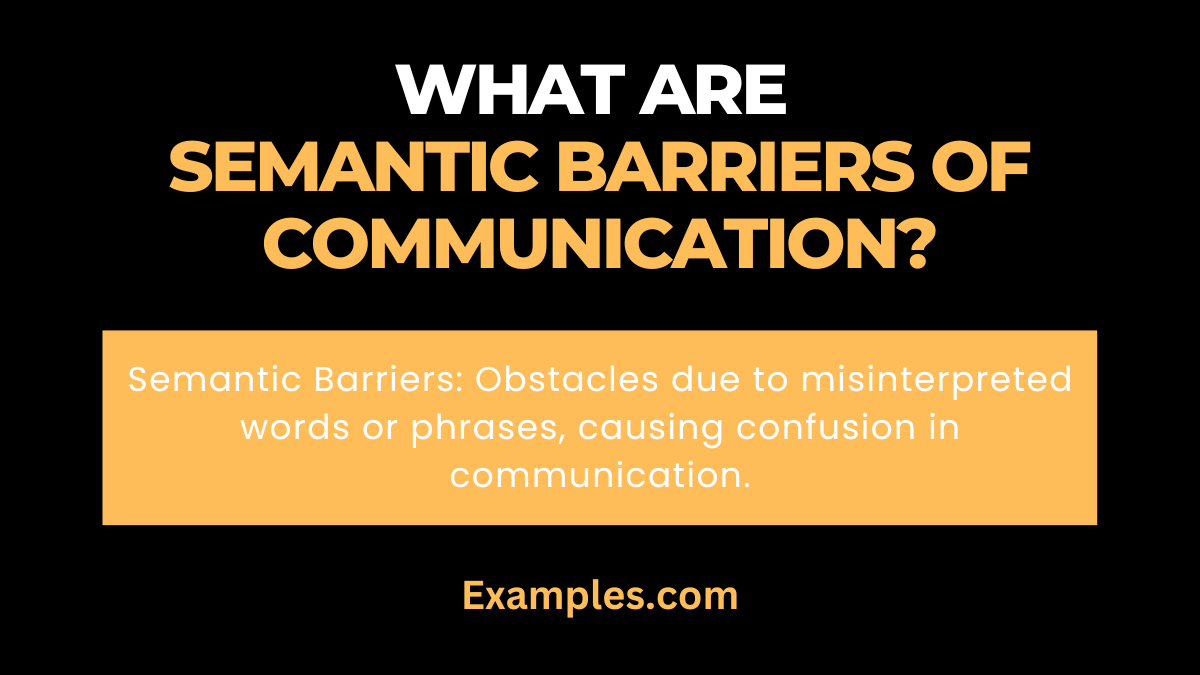
Semantic Barriers of Communication are obstacles to effective communication that occur when words or phrases are misinterpreted or misunderstood. These barriers can arise from ambiguous language, technical jargon, differences in interpretation, and cultural variations in language use. They often lead to confusion, errors in understanding, and can significantly hinder effective communication in both personal and professional settings.
What is the Best Example of Semantic Barriers of Communication?
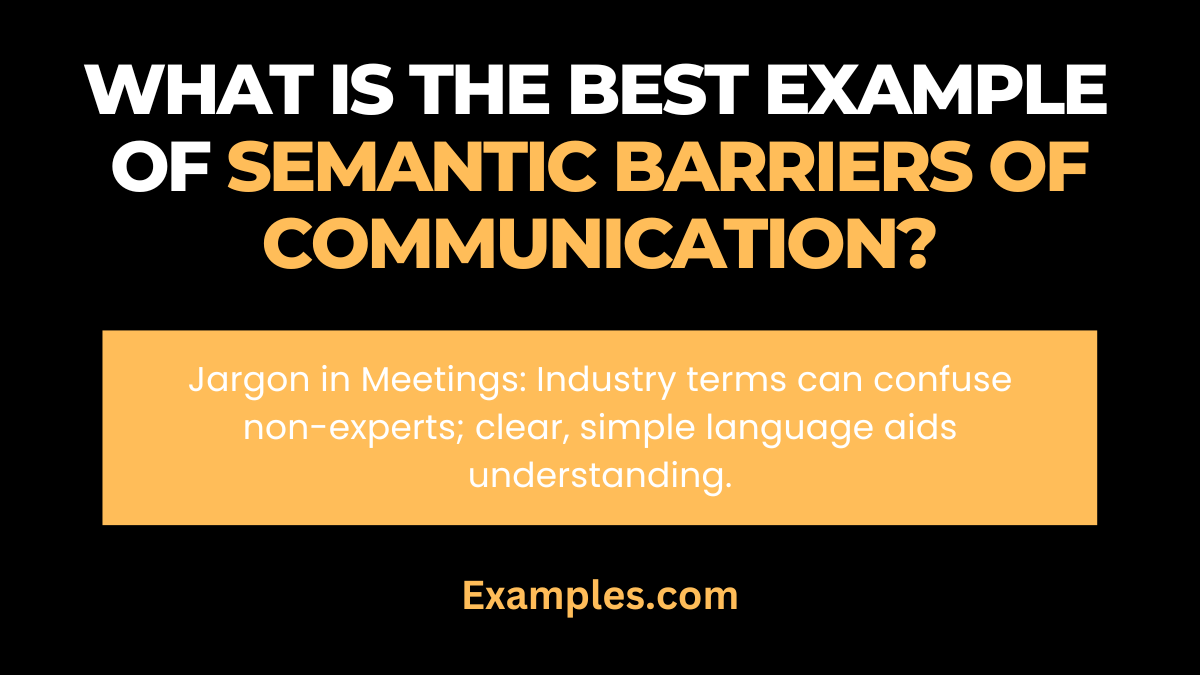
A common example of Semantic Barriers of Communication is the use of industry-specific jargon in a general meeting, leading to confusion among participants unfamiliar with the terminology. This situation highlights the importance of using clear, simple language accessible to all audience members to ensure the message is understood as intended.
20 Semantic Barriers of Communication Examples
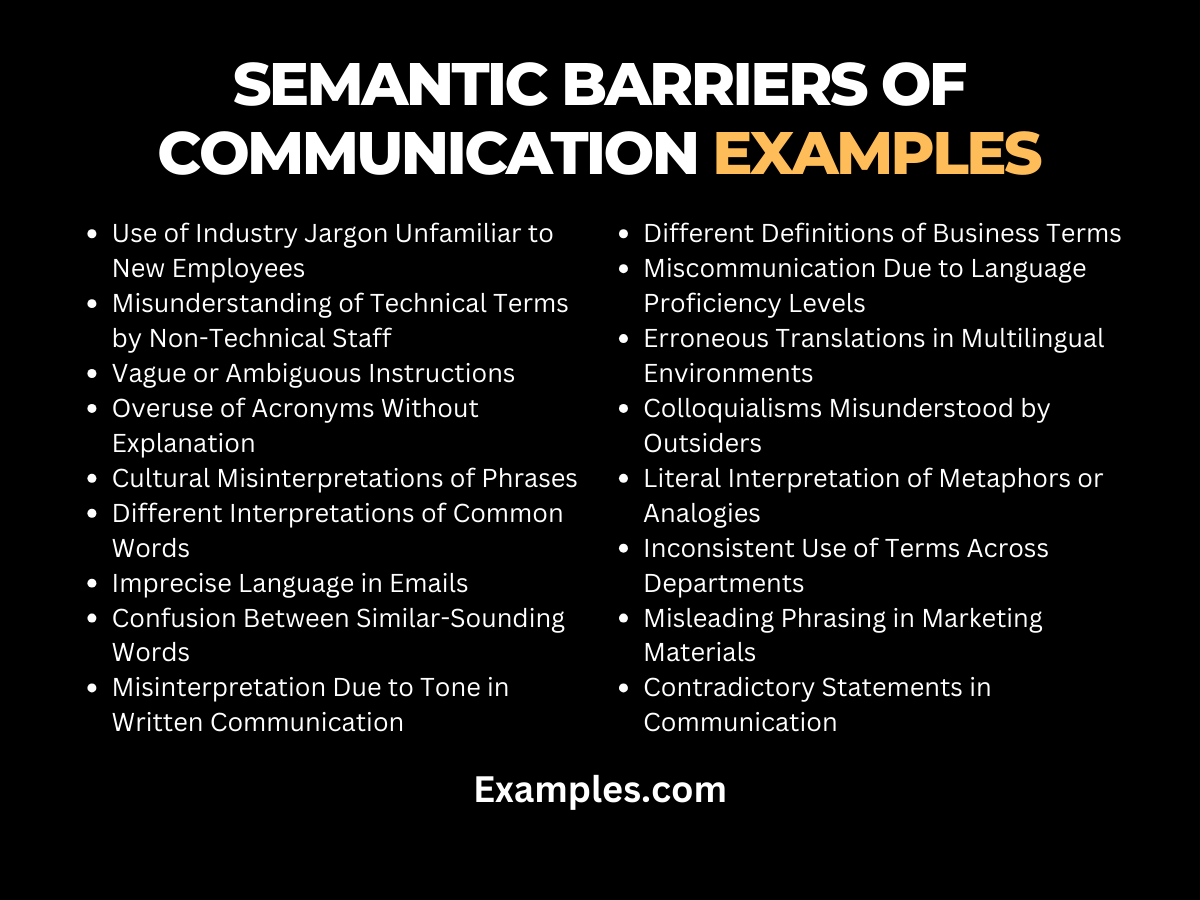
Semantic barriers in communication arise when the meaning of a message gets lost, misinterpreted, or misunderstood due to language and word usage. These barriers can significantly impact understanding and clarity, especially in diverse and dynamic environments like the workplace. Recognizing and addressing these barriers is key to improving communication and ensuring that messages are conveyed and received as intended.
- Use of Industry Jargon Unfamiliar to New Employees: Can lead to confusion and misinterpretation.
Example: “Let’s avoid jargon and explain this process in simple terms.” - Misunderstanding of Technical Terms by Non-Technical Staff: Causes miscommunication between departments.
Example: “I’ll define these technical terms for better understanding.” - Vague or Ambiguous Instructions: Leads to varied interpretations and errors.
Example: “Let me clarify the instructions to ensure we’re on the same page.” - Overuse of Acronyms Without Explanation: New employees or outsiders might feel excluded.
Example: “I’ll spell out the acronym for clarity.” - Cultural Misinterpretations of Phrases: Phrases understood differently in various cultures.
Example: “In this context, this phrase means…” - Different Interpretations of Common Words: Common words can have multiple meanings.
Example: “Let’s define what ‘efficiency’ means in our project.” - Imprecise Language in Emails: Lack of clarity can lead to task mismanagement.
Example: “I’ll rephrase this email for more precision.” - Confusion Between Similar-Sounding Words: Can lead to errors in execution.
Example: “To clarify, I meant ‘compliment,’ not ‘complement.'” - Misinterpretation Due to Tone in Written Communication: Tone is often misconstrued in texts.
Example: “My intention wasn’t to sound harsh. Let’s discuss this in person.” - Assuming Understanding of Local Slang or Idioms: Non-locals might not understand regional expressions.
Example: “Instead of using local slang, let’s use clear, standard language.” - Different Definitions of Business Terms: Can cause strategic misalignments.
Example: “Let’s align our understanding of ‘market expansion.'” - Miscommunication Due to Language Proficiency Levels: Non-native speakers might misinterpret nuances.
Example: “I’ll reword this for clearer understanding.” - Erroneous Translations in Multilingual Environments: Can lead to operational mistakes.
Example: “Let’s use a professional translation service for accuracy.” - Colloquialisms Misunderstood by Outsiders: Can cause feelings of exclusion or confusion.
Example: “Let’s use more inclusive language in our meetings.” - Literal Interpretation of Metaphors or Analogies: Can be confusing for some individuals.
Example: “To clarify, this metaphor means…” - Inconsistent Use of Terms Across Departments: Leads to confusion and inefficiency.
Example: “We should standardize our terminology across all departments.” - Confusion Caused by Homonyms: Words sounding the same but having different meanings.
Example: “To avoid confusion, ‘right’ here means correct, not direction.” - Misinterpretation of Corporate Buzzwords: Buzzwords can be vague or misleading.
Example: “Let’s explain what ‘synergy’ means in our context.” - Misleading Phrasing in Marketing Materials: Can create unrealistic customer expectations.
Example: “Our marketing language should accurately reflect our product’s capabilities.” - Contradictory Statements in Communication: Leads to distrust or uncertainty.
Example: “We need to ensure our messages are consistent and not contradictory.”
Addressing these Semantic Barriers of Communication involves using clear, simple language, considering the audience’s background, and ensuring consistent terminology, thereby enhancing understanding and effectiveness in communication.
Semantic Barriers of Communication in the Workplace
Semantic barriers in communication occur when misunderstandings arise due to differences in meaning, interpretation, or perception of words and language styles. In the workplace, these barriers can lead to confusion, inefficiency, and misaligned goals. They often stem from jargon, technical language, cultural language differences, or simply the way messages are phrased or interpreted.
- Jargon and Technical Language: Using industry-specific terms that not all employees understand.
- Cultural Language Differences: Misunderstandings arising from non-native speakers interpreting phrases literally.
- Ambiguity in Instructions or Messages: Vague language leading to unclear expectations.
- Overuse of Abbreviations and Acronyms: Confusion caused by unfamiliar abbreviations.
- Different Interpretations of Words: Words having multiple meanings leading to confusion.
- Misinterpretation of Tone in Written Communication: Tone in emails or memos misunderstood.
- Assumptions Based on Past Conversations: Misunderstanding current context due to past references.
- Language Barrier Among Diverse Teams: Miscommunication due to varying levels of language proficiency.
- Use of Idioms or Slang: Local idioms or slang causing confusion among non-native speakers.
- Inconsistent Terminology: Inconsistencies in terms used across departments or teams.
Addressing Semantic Barriers is crucial for effective workplace communication. It involves clear, concise messaging and consideration of the audience’s language and cultural background.
Types of Semantic Barriers of Communication
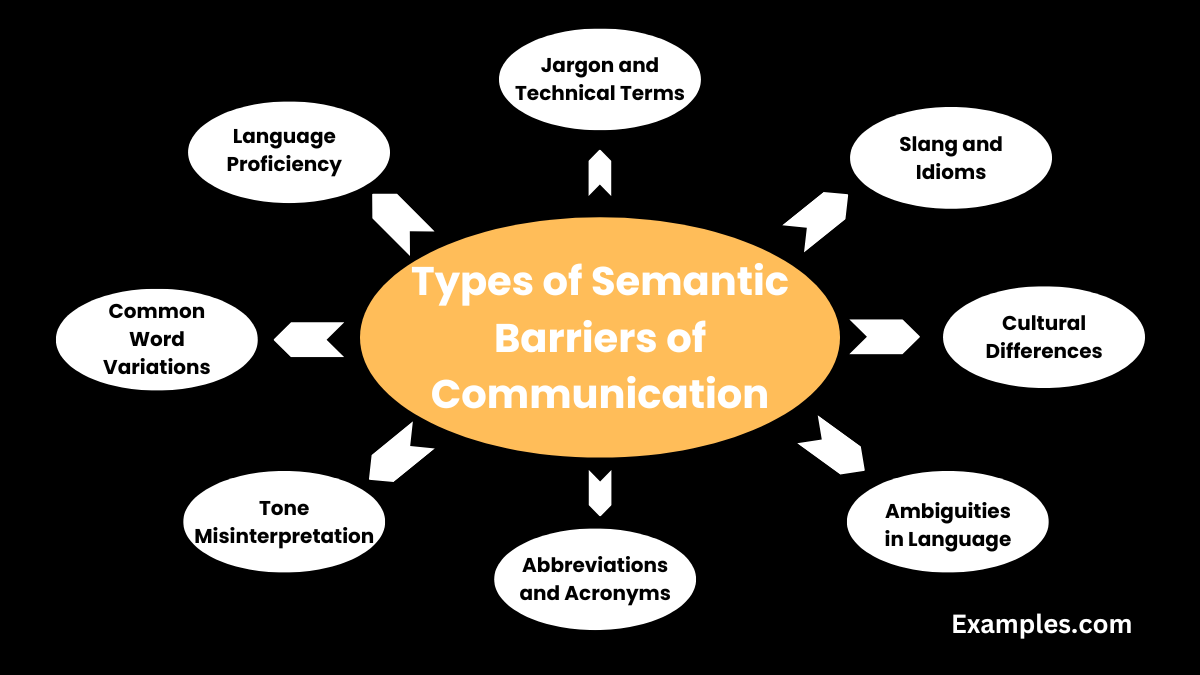
Semantic Barriers of Communication are crucial obstacles that arise from differences in language interpretation and meaning. These barriers can significantly impede understanding and effective communication in various settings. They are particularly prevalent in diverse workplaces, where language, culture, and personal backgrounds vary widely.
- Jargon and Technical Language: Specialized terms understood only within certain groups.
- Use of Slang and Idioms: Colloquial expressions that may be unfamiliar to some.
- Cultural Language Differences: Words and phrases carrying different meanings across cultures.
- Ambiguities in Language: Vague or double-meaning words causing confusion.
- Overuse of Abbreviations and Acronyms: Can be unclear to those outside a specific field.
- Misinterpretation of Tone: Especially in written communications where tone is hard to gauge.
- Varying Interpretations of Common Words: Common words having different meanings in different contexts.
- Language Proficiency Levels: Varied levels of language skill leading to misunderstandings.
How to Overcome in Semantic Barriers of Communication
Overcoming Semantic Barriers of Communication involves awareness and proactive strategies to ensure clarity and mutual understanding. It’s crucial in diverse environments for effective communication.
- Use Clear and Simple Language: Avoid jargon and complex phrases.
- Provide Definitions for Technical Terms: When jargon is unavoidable, offer clear explanations.
- Be Mindful of Cultural Differences: Understand and respect linguistic nuances across cultures.
- Use Specific and Unambiguous Language: Avoid vague statements and be precise.
- Explain or Avoid Slang and Idioms: Use standard language or explain colloquial terms.
- Clarify Written Communications: Ensure the tone and intent are clear in texts and emails.
- Regular Feedback and Clarification: Encourage questions and clarifications for better understanding.
- Language Training and Support: Offer language support for non-native speakers.
Incorporating these strategies can greatly reduce Semantic Barriers of Communication, fostering a more inclusive and effective communication environment.
Effectively navigating Semantic Barriers of Communication is essential for clear and successful interactions in diverse settings. By understanding the types of semantic barriers and implementing strategies to overcome them, such as using simple language and being culturally aware, communication can become more inclusive and effective. This guide offers valuable insights and practical tips for addressing these barriers, fostering better understanding and collaboration.



